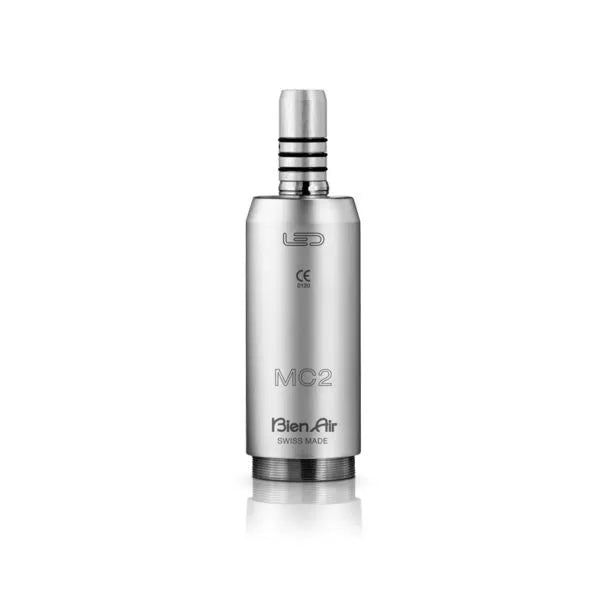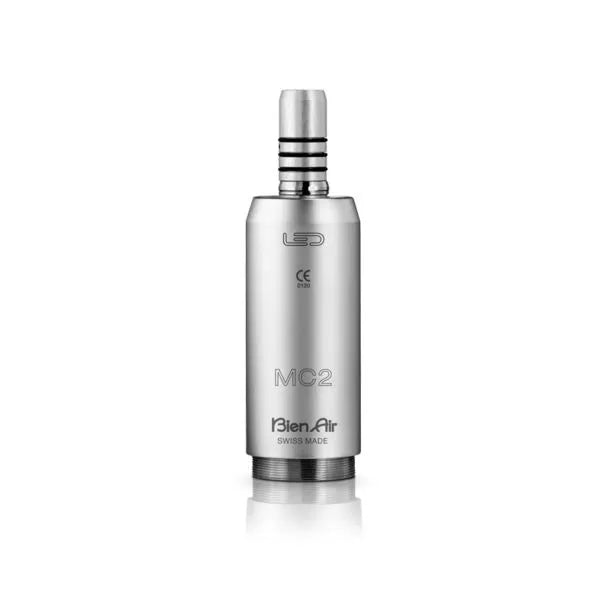1
/
of
1
Bien Air Micromotor MC2 Carbon Brush 60-40K RPM w/ LED Light
BIE-1600681-001Bien Air Micromotor MC2 Carbon Brush 60-40K RPM w/ LED Light
Regular price
$1,074.99
Sale price
$1,074.99
Regular price
Unit price
/
per
Description
HOW DO THE MC3 CARBON BRUSH MICROMOTOR WORK?
All electric micromotors are made up of a rotor and a stator. The rotation is generated by magnets interacting with an electric current flowing through a wire coil. In the case of brush micromotors, the coils are located on the rotor. Electrical power is supplied to the coils through carbon brushes located on the stator. The electrical current in the coil interacts with the magnets of the stator, thus generating rotation.
COMPLEXITY OF BRUSH MICROMOTORS.
Complex mechanical design (rotor: multiple windings, collector and brushes, stator: permanent magnet). The brushes wear out so they must be regularly replaced (approximately 18-24 months in a dental micromotor). The carbon dust from the brushes
disperses in the micromotor and can reduce the life of the micromotor bearings. The carbon brushes can cause interference with other electronic devices because of their constant interaction with the electrical components in the micromotor. The carbon brushes cannot be washed or sterilized as they absorb moisture generated from an air compressor.
MICRO-SERIES. WELCOME TO A NEW DIMENSION.
Bien-Air’s new generation Micro-Series models ally innovation with compact design, resulting in improved power and maneuverability. Up to 30 percent shorter and 23 percent lighter than traditional models, they have an easy grasp that allows for optimal work comfort with less strain on the hand, arm, and shoulder.
Side by Side comparison of MC2 & MC3 for your convenience:
Includes: Bien Air Micromotor MC2 Carbon Brush 60-40K RPM w/ LED Light
All electric micromotors are made up of a rotor and a stator. The rotation is generated by magnets interacting with an electric current flowing through a wire coil. In the case of brush micromotors, the coils are located on the rotor. Electrical power is supplied to the coils through carbon brushes located on the stator. The electrical current in the coil interacts with the magnets of the stator, thus generating rotation.
COMPLEXITY OF BRUSH MICROMOTORS.
Complex mechanical design (rotor: multiple windings, collector and brushes, stator: permanent magnet). The brushes wear out so they must be regularly replaced (approximately 18-24 months in a dental micromotor). The carbon dust from the brushes
disperses in the micromotor and can reduce the life of the micromotor bearings. The carbon brushes can cause interference with other electronic devices because of their constant interaction with the electrical components in the micromotor. The carbon brushes cannot be washed or sterilized as they absorb moisture generated from an air compressor.
MICRO-SERIES. WELCOME TO A NEW DIMENSION.
Bien-Air’s new generation Micro-Series models ally innovation with compact design, resulting in improved power and maneuverability. Up to 30 percent shorter and 23 percent lighter than traditional models, they have an easy grasp that allows for optimal work comfort with less strain on the hand, arm, and shoulder.
Side by Side comparison of MC2 & MC3 for your convenience:
| MC2 LED | MC3 LED | |
| Applications | Restorative, Prophylaxis | Restorative, Prophylaxis |
| Type | With brushes, internal spray | With brushes, internal spray |
| Speed range | 60-40,000 rpm | 60-40,000 rpm |
| Max torque | 2.3 Ncm | 2.8 Ncm |
| Torque control | No | No |
| Weight (g) | 72 gr | 98 gr |
| Dimensions | Ø 23 x 79 mm | Ø 21 x 95 mm |
| Light | LED with adjustable intensity | LED with adjustable intensity |
| Max noise level, compliant with ISO 11498 | 54 dBA | 54 dBA |
| Sterilisable | No | No |
| Hose rotation | 0° | 400° |
| Warranty | 1.5 to 2.5 years 1 | 1.5 to 2.5 years 1 |
Includes: Bien Air Micromotor MC2 Carbon Brush 60-40K RPM w/ LED Light


